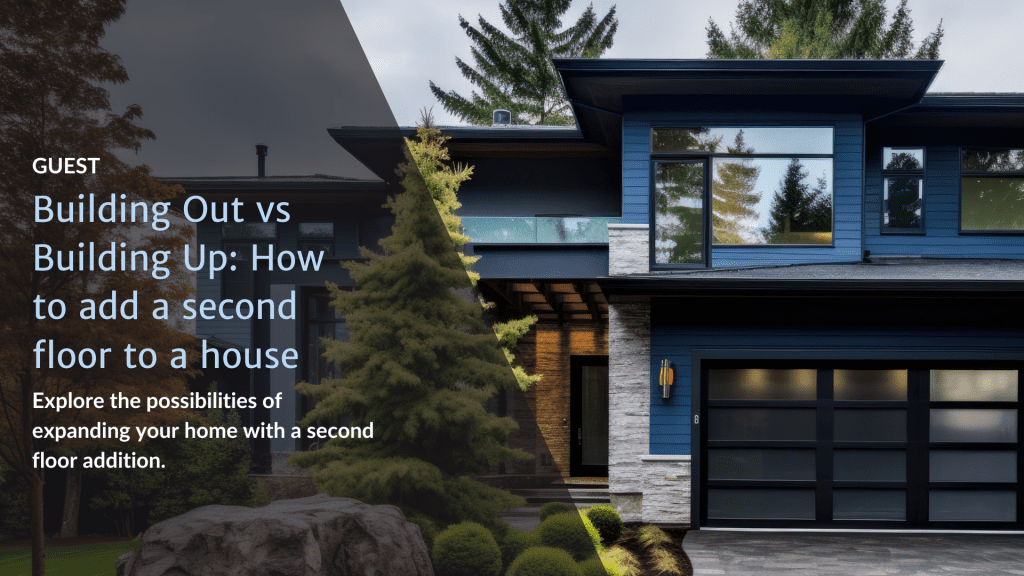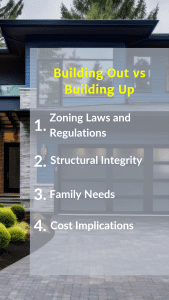
Building Out vs Building Up: How to add a second floor to a house
As your family grows or needs evolve, the demand for additional space becomes imminent. With this, you're faced with two primary options: extend the footprint of your house horizontally or venture upwards, adding a second floor. Each approach bears its own set of considerations, benefits, and challenges. So, today, we're looking at building out vs building up and discussing how to add a second floor to a house.
Cost Implications of Adding a Second Floor
So, you're leaning towards building up. It's a choice that promises the allure of additional space without sacrificing your yard. But how much to add a second floor to a house? Here's what to consider:
- Structural Assessment and Reinforcement: Before the first nail is driven, a structural assessment is crucial. The existing foundation and walls must be evaluated to ensure they can bear the additional load. Reinforcements might be necessary, adding to the initial cost.
- Construction Costs: This is the bulk of the expense. It includes materials, labor, and other related costs. Each square foot added brings a specific price, influenced by factors like the quality of materials and complexity of the design.
- Architectural and Design Fees: Professional input is invaluable in ensuring the new addition blends seamlessly with the existing structure, both functionally and aesthetically.
- Permit and Inspection Fees: Adding a second floor necessitates adherence to specific regulatory and safety standards. There are costs attached to securing the requisite approvals and inspections.
- Additional Costs: Think of the ancillary yet unavoidable expenses. Temporary accommodation if you need to move out during construction, storage for your belongings, and any landscape restoration post-construction.
In other words, while adding a second story can solve space constraints without taking up your outdoor space, it is a major investment. Therefore, a detailed financial plan, taking into account both the obvious and often overlooked expenses, is essential for planning and preparation.
How to Add a Second Floor to an Existing House
Adding a second floor to your home isn't just about the extra space - it's a transformative process that impacts the entire structure. It requires meticulous planning, professional insight, and adherence to regulatory standards. Here's how to add a second floor to a house:
Step 1: Consultation and Planning
Engage professionals for a comprehensive assessment of the existing structure. Together you will collaborate on a design that fuses aesthetic goals with functional needs and regulatory compliance.
Step 2: Approval and Permits
Secure the necessary permits. This often involves submitting detailed plans for approval by local authorities to ensure adherence to safety and zoning regulations.
Step 3: Preparation
Prepare the existing structure. This process might involve reinforcing the foundation or making other necessary adjustments to support the additional weight.
Step 4: Construction
This marks the start of the building process, which includes framing the new level, installing electrical and plumbing systems, and completing interior and exterior finishes.
Step 5: Inspection
Have the work inspected at different stages to ensure it meets the established safety and quality standards.
Step 6: Finishing Touches
Complete the final touches, such as painting and installing fixtures, to transform the new space into a livable area.
Key Considerations for Adding Space
The decision to add space to your home comes with several considerations. While the extra room is a tangible benefit, the route you take to achieve this - building up or building out - should be influenced by a combination of factors:
- Zoning Laws and Regulations: Understand the legal parameters within your locality. Keep in mind that some areas have restrictions on building height or proximity to the property line.
- Structural Integrity: Assess the existing structure's capability to support additional weight. This is especially crucial when adding a second floor.
- Family Needs: Consider the specific needs of your family. For instance, building up provides extra space without reducing the yard area, which is a valuable aspect for families who prioritize outdoor living.
- Cost Implications: Weigh the financial aspect, considering both the immediate cost and the potential impact on the property's value.
- Construction Impact: Consider the level of intrusion and inconvenience, including whether you'll need to vacate the premises during construction.
Each option, building out or up, presents unique opportunities and challenges. Balancing your family's needs, budget, and legal constraints with your long-term goals for the space is crucial to arriving at a decision that brings lasting satisfaction and value.
Benefits of Building Up vs Building Out
Opting to extend your home vertically by adding a second floor can offer a myriad of benefits. While the consideration of cost and construction are paramount, the advantages often make this option an attractive one.
- Increased Living Space: Doubling up your home's height effectively increases your living area without spreading into your yard or garden.
- Property Value Boost: A second story can significantly enhance your property's market value, making it a sound long-term investment.
- Improved Views: Elevating your living space often comes with enhanced views, adding aesthetic value to the functional gains.
- Energy Efficiency: Building up can be more energy-efficient, resulting in potential savings on heating and cooling costs.
- Customization Opportunities: It offers a chance to modernize your home, allowing you to customize the new space to your precise specifications.
Financing the Addition
Funding a second-floor addition requires thoughtful financial planning. Here are some avenues to consider:
- Savings: Utilizing personal savings to finance the project is the most straightforward option but requires significant upfront financial capability.
- Home Equity Loan: Borrowing against your home's equity can provide the needed funds at potentially lower interest rates.
- Construction Loan: A short-term loan that covers the construction period, often convertible to a traditional mortgage once construction is complete.
- Refinancing: Restructuring your existing mortgage to withdraw some of your home equity for the project.
Your Next Step in Home Expansion
Expanding your home is a significant decision, and there are many factors to consider. But don't worry, we're here to help. We offer personalized solutions for every unique home and family, and we're committed to turning your vision into reality. Let's explore this journey together and create a home that's spacious, functional, and truly yours.
Mini-FAQs
Adding a second story or building out both come with their own challenges. Building out typically involves less structural work but requires available land space. Adding a second story can be complex, as it involves reinforcing the foundation, ensuring structural integrity, and handling stairs. The choice depends on your home's layout, budget, and the desired increase in living space.
The cost of adding a second story versus building out can vary widely. Building out may seem less expensive initially, as it doesn't involve major structural changes. Adding a second story often requires more significant structural work, making it costlier. However, the final cost depends on factors like local labor rates, materials, and the complexity of the project. It's essential to obtain detailed quotes from contractors to make an informed decision.
Evaluating your foundation's ability to support a second story is crucial. Consult with a structural engineer or a professional contractor who can assess the foundation's load-bearing capacity. They will consider factors like soil conditions, foundation type, and the need for additional support beams or piers. A thorough inspection is necessary to ensure the safety and stability of your home.
Adding a second floor to an existing home is a complex undertaking. It involves various stages, including reinforcing the foundation, extending utilities, and building the new structure. The difficulty level depends on factors like the existing structure's condition, local building codes, and the design complexity. It's generally considered a major renovation project that requires careful planning, professional expertise, and adherence to safety regulations.

